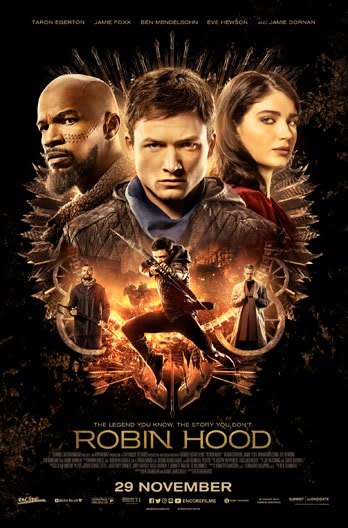Everything you need to know about Robin Hood in 10 minutes
Everyone’s heard of Robin Hood in some form, whether it be the comedy musical film Robin Hood: Men in Tights, the 1973 Disney animated movie Robin Hood (wonder when we’ll get to see a live-action version of that?), or this year’s Robin Hood (starring Taron Edgerton and Jamie Foxx). But how much do you know of the original legend of Robin Hood?
The legend of Robin Hood dates back to the 14th century. By 1377, Robin Hood had already become a literary figure in ballads and stories, although historians still can’t quite figure out if the legend was based on a real person or not. It’s interesting to note that in the 13th century, the names “Robehod” and “Rabunhod” were used to refer to criminals, which is probably the origin of Robin Hood we know today.
So here’s a quick primer everything you need to know about Robin Hood, the important characters and events in his life. After reading this article, you can go quiz your friends on Robin Hood and astound them with your knowledge of the legend!
Who was Robin Hood?
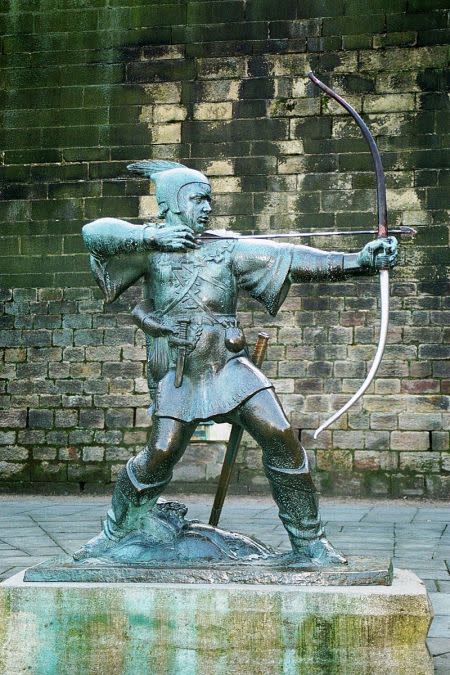
A statue of Robin Hood in Nottingham. Credit: Wikipedia
Robin Hood has many different origins (depending on which version of the legend you’re reading), but they all agree on two things – he’s a fantastic archer, and he wears green. Modern day archers can fire up to three arrows in 0.6 seconds (such as Lars Andersen), so imagine how speedy Robin Hood would have been with a bow, since he probably fired them every day! Skilled archers could also fight with a bow and arrow in close quarters, so it’s no surprise that Robin Hood would have been just as effective in melee combat as he was in ranged combat.
Style-wise, most books agree that Robin Hood’s outfit was a very specific shade of green – Lincoln green, to be exact. Robin Hood’s team of outlaws, the Merry Men, also wore Lincoln green. If you’re wondering what other colours were available to them, they could have opted for Coventry blue or Kendal green too. Back in Robin Hood’s time, these colours were named after the towns which produced cloth of these colours, so Lincoln green originally came from the cathedral city of Lincoln.
Robin Hood’s Merry Men were based in Sherwood Forest, which was where an important trade route would cut through. By basing themselves in Sherwood Forest, they could raid the caravans of the wealthy as they passed through.
Robin Hood’s allies – Little John and Maid Marian
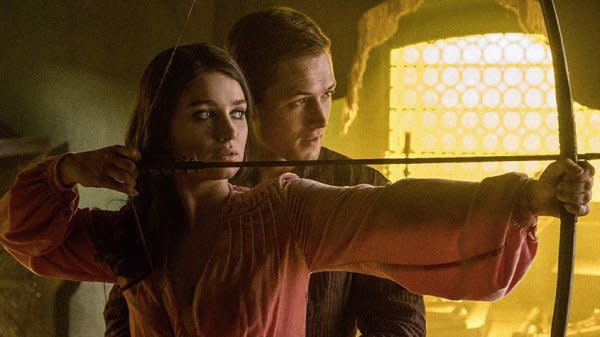
Eve Hewson as Maid Marian and Taron Edgerton as Robin Hood in Robin Hood. Credit: Golden Village Cinemas
Robin Hood’s best friend and deputy commander of the Merry Men was Little John. Contrary to his name, Little John was tall and broad, and probably the most physically powerful of Robin Hood’s Merry Men. He first met Robin Hood at a crossing, where they duelled using thick wooden staves (and rapping at each other’s knuckles). Although Little John defeated Robin Hood, he still joined the Merry Men under the leadership of the outlaw. Little John’s real name was “John Little”, but Robin Hood christened him Little John as a humorous reference to his size and power.
Maid Marian (sometimes spelled Marion) was Robin Hood’s girlfriend, and she was an strong female character, capable of holding her own in conversations with Robin Hood. Since they were all outlaws living in Sherwood Forest, Maid Marian was just as adept as the rest of the Merry Men in hunting, foraging and fighting.
Robin Hood’s Merry Men had many other colourful characters – his nephew Will Scarlet, the jolly Friar Tuck and Alan-a-dale, a bard. They subsisted on venison in Sherwood Forest, by hunting and eating the King’s deer. However, since they considered themselves loyal to the crown, they rationalised that it was alright to eat the King’s deer, because they were sort of doing the King’s work.
Enemies – the Sheriff of Nottingham and Prince John
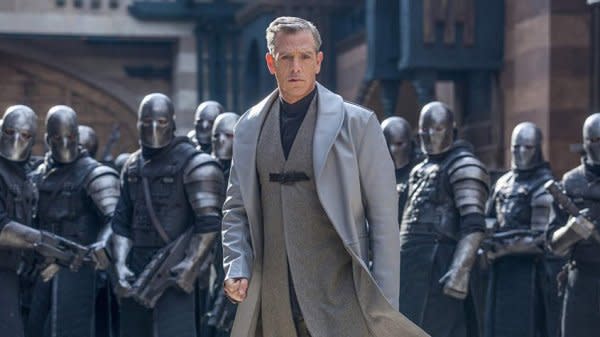
Ben Mendelsohn as the Sheriff of Nottingham in Robin Hood. Credit: Golden Village Cinemas
Robin Hood’s chief nemesis was the Sheriff of Nottingham… who was never really given an actual name. He was usually referred to by his title, the Sheriff of Nottingham. As the Sheriff (and a law enforcement officer), his job was to ensure the safety of the people, which was why he was so persistent in trying to capture Robin Hood. Unfortunately, being a corrupt Sheriff, he was more interested in oppressing the people and bleeding every last tax dollar from them.
The other, more sinister enemy of Robin Hood was Prince John. Unlike the Sheriff, who had petty concerns, Prince John wanted to usurp the throne of England while the true King was away. In the stories of Robin Hood, the rightful king of England, King Richard the Lionheart, was off fighting a war. Robin Hood considered himself loyal to King Richard, and opposed Prince John’s plans to become king.
We know – there’s two Johns in the story, Little John and Prince John. John was a common name.
Robin Hood’s demise
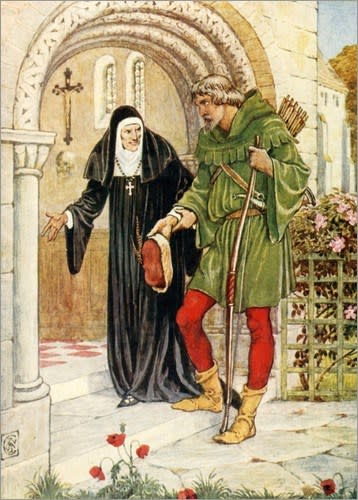
The cunning Prioress alongside her cousin, Robin Hood. Credit: Robin Hood Wiki
You’d think that Robin Hood would have met with a spectacular death, defeating all his enemies in a blaze of glory right? In actual fact, his death was a rather sad and painful one.
You see, after getting a nasty wound in battle, Robin Hood seeks out his cousin, the Prioress of Kirklee Abbey. She was skilled at bloodletting, a common treatment for illnesses and wounds at the time. However, the Prioress secretly hated Robin Hood. After cutting Robin Hood and letting him bleed for awhile, she bandaged his wound – but left it so loose that he continued bleeding anyway. When Robin Hood discovered this treachery, he was too weak to escape.
All he could do was blow his horn to summon Little John. When his best friend arrived, Robin Hood asked to fire one last arrow. His last wish was to be buried where the arrow landed.
This also meant that Robin Hood was ended up being buried somewhere near the abbey where the Prioress of Kirklees resided, instead of Sherwood Forest. But Little John honoured this promise, and etched this on Robin Hood’s grave:
Here, underneath this stone,
Lies Robert, Earl of Huntingdon;
No archer ever was so good,
The people called him Robin Hood.
Such outlaws as he and his men
Will England never see again.
Robin Hood. Credit: Golden Village Cinemas
Now that you know all about the legend of Robin Hood, are you ready to watch the new big budget adaptation of the Robin Hood legend? In Robin Hood, we get a bold new reinterpretation of the Robin Hood legend, showing us a fresh take on the Robin Hood story and depicting his heroics with high octane action.
Taron Edgerton plays the title character, with Jamie Foxx as Little John and Eve Hewsen as Maid Marian. Jamie Dornan from Fifty Shades plays Will Scarlet in this adaptation, which has quite a few interesting twists on the legend.
What happens in Robin Hood? More importantly, will he survive – or does he fall prey to the Prioress of Kirklee Abbey in this series?
You’ll have to watch the legend of Robin Hood for yourself to find out.
Credits: Golden Village Cinemas, Robin Hood Wiki, Wikipedia
Follow The Popping Post on Facebook and Instagram for more fun and exciting reads!
The post Everything you need to know about Robin Hood in 10 minutes appeared first on The Popping Post.

